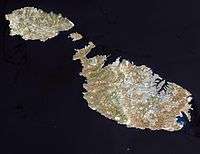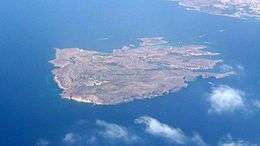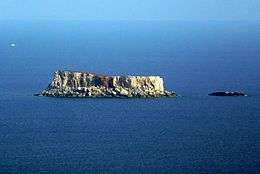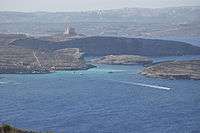Geography of Malta



The geography of Malta is dominated by water. Malta is an archipelago of coralline limestone, located in the Mediterranean Sea, approximately 93 kilometres south of Sicily, Italy, and nearly 300 km north (Libya) and northeast (Tunisia) of Africa. Although Malta is situated in Southern Europe, it is located farther south than African Tunis, capital of Tunisia, Algiers, capital of Algeria, Tangier in Morocco and also Aleppo in Syria, and Mosul in Iraq in the Middle East. Only the three largest islands – Malta, Gozo and Comino – are inhabited. Other (uninhabited) islands are: Cominotto, Filfla and the St.Paul's Islands. The country is approximately 316 km2 (122 sq mi) in area. Numerous bays along the indented coastline of the islands provide good harbours. The landscape of the islands is characterised by high hills with terraced fields. The highest point, at 253 metres, Ta' Zuta on mainland Malta. The capital is Valletta.
Geographic coordinates: 35°50′N 14°35′E / 35.833°N 14.583°E
Statistics
Map references: Europe
Area:
- Total: 315.718 km2[1]
- Land: 315.718 km2
- Water: 0 km2
Area - comparative: slightly less than twice the size of Washington, DC
Land boundaries: 0 km
Coastline: 196.8 km (excludes the 56 km for the island of Gozo)
Maritime claims:
- Territorial sea: 12 nmi (22.2 km; 13.8 mi)
- Contiguous zone: 24 nmi (44.4 km; 27.6 mi)
- Continental shelf: 200 m depth or to the depth of exploitation
- Exclusive fishing zone: 25 nmi (46.3 km; 28.8 mi) Malta
Islands
| Name | Area | Note/ coordinates |
Image |
|---|---|---|---|
| Malta Island | 245.758 km²[1] |  | |
| Gozo | 67.078 km²[1] |  | |
| Comino | 2.784 km²[1] |  | |
| Manoel Island | 0.3 km² | _01_ies.jpg) | |
| St Paul's Island | 0.101 km²[1] |  | |
| Cominotto | 0.099 km²[2] | _03_ies.jpg) | |
| Filfla (and Filfoletta) | 0.020 km²[1] |  | |
| Fungus Rock | 0.007 km²[1] | | |
| Halfa Rock | Situated near Gozo. In the island there is 4 to 5 metres deep water rock pool just 2 metres above sea level, possibly man made due to its perfectly round shape. There is also an underground fresh water system which emerges from a small cave. Most of the plants occurs on the western part of the island. Crucianella rupestris, Arthrocnemum macrostachyum, Lygeum spartum, Convolvulus oleifolius, Thymbra capitata, Teucrium fruticans, Allium melitense, Anacamptis urvilleana, Bromus madritensis, Capparis spinosa, Echium parviflorum, Pallenis spinosa, Plantago lagopus, Trachynia distachya, Urginea pancration.[2] | ||
| Old Battery’s Rock | Situated on the southeast of Comino. Flora consisted of 22 individuals of Inula crithmoides (2010).[2] | ||
| Lantern Point Rock | Situated near Comino.[2] Live here two species of plants: Limonium melitense and Inula crithmoides. It has a height of 7 meters.[3] | _01_ies.jpg) | |
| Large Blue Lagoon Rock | In island, there is a cave. Species of plants: Hypericium aegypticum, Daucus carota, Convolvulus oleifolius, Darniella melitensis, Arthrocnemum macrostachyum, Senecio bicolor.[2] |  | |
| Small Blue Lagoon Rocks | Situated between Large Blue Lagoon and Cominotto. Species of plants: Arthrocnemum macrostachyum, Daucus carota, Lygeum spartum, Lavatera arborea.[2] | _01_ies.jpg) | |
| Devil`s End Rock | Situated near main island, Delimara point. | | |
| Għallis Rocks |  | ||
| Tac-Cawl Rock | Situated near Gozo. The flora consisted of Lygeum spartum, Asphodelus aestivus, Crithmum maritimum, Cichorium spinosum, Crucianella rupestrisis, Opuntia, Thymbra capitata, Euphorbia melitensis, Foeniculum vulgare, Allium commutatum, Allium lajoconoi, Bromus madritensis, Capparis spinosa, Gynandriris sisirynchium, Pistacia lentiscus, Phagnalon graceum, Sedum litoreum, Sonchus tenerrimus, Trachynia distachya, Valantia muralis.[2] | ||
| Cheirolophus Rock | Situated near main island. It has a height of 9 to 12 meters high at its highest point. Species of plants: Darniella melitensis, Crithmum maritimum, Cheirolophus crassifolius, Inula crithmoides, Limonium virgatum, Daucus carota, Cheirolophus crassifolius.[2] | ||
| Barbaganni Rock | Situated near Gozo. No soil exists on the islet because island is inundated by water wave action during rough weather. The flora consisted of only 14 individuals of Inula crithmoides (2010).[2] | ||
| Crocodile Rock & Bear Rocks
Orsijiet) |
Near Gozo, three rocks in total.[2] | ||
| Qawra Point | Situated near main island. The western part is littered with small boulders, while much of the vegetation occurs in the middle part of the islet. In island there is sea cave occurs as a big hole in the middle of the islet. Species of plants: Arthrocnemum macrostachyum, Anthemis urvilleana, Inula crithmoides, Lotus cystisoides, Limonium, Sporbolus pungens.[2] | ||
| Comino Cliff Face Rock | Situated near Comino. The island is very steep - cliffs. The majority of species of plants occur on its west side, while only one species of plant inhabits its east side. Species of plants: Matthiola incana, Inula crithmoides, Darniella melitensis, Daucus carota, Limonium melitensis, Anthyllis hermanniae, Pistacia lentiscus.[2] | ||
| Xrobb l-Ghagin Rock | |||
| Fessej Rock | |||
| Ghemieri Rocks | |||
| Hnejja Rocks | |||
| White Rock / Blue Islets (Rocks) |
Climate
See also: Climate of Malta
Mediterranean with mild, rainy winters and hot, dry summers.
Elevation extremes
- Lowest point:
Mediterranean Sea 0 m
- Highest point:
Ta' Dmejrek 253 m
Land use
- Arable land: 28.12%
- Permanent crops: 4.06%
- Other: 67.81% (2011)
Irrigated land
32 km2 (2007)
Total renewable water resources
.jpg)
0.05 km3 (2011)
Environment
Current issues
Limited natural fresh water resources; increasing reliance on desalination.
International Agreements
- Party to: Air Pollution, Biodiversity, Climate Change, Climate Change-Kyoto Protocol, Desertification, Endangered Species, Law of the Sea, Marine Dumping, Ozone Layer Protection, Ship Pollution, Wetlands
signed, but not ratified:
References
- 1 2 3 4 5 6 7 State of the Environment Report for Malta 1998
- 1 2 3 4 5 6 7 8 9 10 11 12 "Topography and Flora of the Satellite islets surrounding the Maltese Archipelago" - Arnold Sciberras, Jeffrey Sciberras, 2010
- ↑ "A contribution to the knowledge of the terrestrial Mammalian fauna of Comino and its satellite islets (Maltese Archipelago)" - Biodiversity Journal, 2012, 3 (3): 191-200